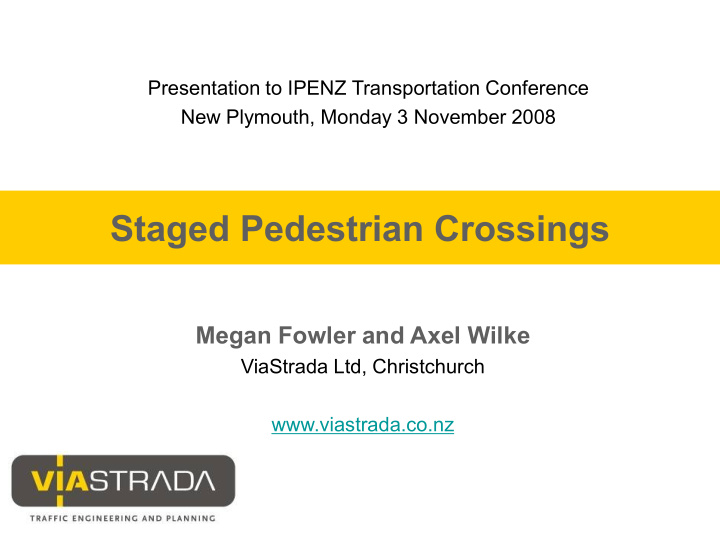



Presentation to IPENZ Transportation Conference New Plymouth, Monday 3 November 2008 Staged Pedestrian Crossings Megan Fowler and Axel Wilke ViaStrada Ltd, Christchurch www.viastrada.co.nz
Presentation outline • Introduction • Components of staged pedestrian crossings • Modelling • Case study • Discussions • Conclusions
Introduction • A typical pedestrian crosswalk operation in NZ: • Allowing filter turning vehicles significantly decreases pedestrian safety • Exclusive pedestrian protection decreases efficiency
Introduction • Why not try a staged pedestrian crossing? • Separates crossing tasks • Allows for full (or increased) protection without decreasing efficiency
Components of SPCs • Refuge island • Staggered • Stagger ≥ 3 m • Lefthand stagger preferred – ensures peds walk towards opposing traffic
Components of SPCs • Traffic signal phasing • Operates as two separate crosswalks • Coordination depends on demand at intersection • Different phasing possibilities P2 depending on location of P1 pedestrian demand
Components of SPCs • Assisting infrastructure • Signal aspects • Signage • Low cover landscaping LOOK LEFT WAIT FOR GREEN
Modelling • SIDRA not too good at modelling effects of pedestrians based on pedestrian volume data • Best to model based on late starts to vehicles that occur when crosswalk phase demanded • This requires demand data
• SCATS IDM data Modelling Number of calls in period 10 12 14 16 18 20 0 2 4 6 8 08:00 08:30 09:00 09:30 10:00 10:30 11:00 11:30 Start of half hour time period 12:00 12:30 13:00 13:30 14:00 14:30 15:00 15:30 16:00 16:30 17:00 17:30 18:00 P4 P2 P3 P1 18:30
Modelling • SCATS IDM data • Average demand P1 - demanded rates every 3 cycles Right turner – • Late starts when delayed 9 s if ped crossing demanded • Average late starts 3 s late start
Case study • Bealey Avenue, Christchurch – Manchester Street – Colombo Street – Durham Street
Case study • Applying the modelling method: Spare capacity Average delay LOS (s/person) Side road Base SPC Base SPC Base SPC Manchester -14% -10% 39.0 34.9 D C Colombo -19% -18% 49.1 45.7 D D Durham am -10% -10% 51.4 50.4 D D Durham pm 8% 10% 35.7 33.4 D C
Discussions • Are staged pedestrian crossings unsafe because they require pedestrians to wait in the centre of the road? – Phasing should be designed to minimise this occurrence – Refuge should be designed to offer actual and perceived safety – What about the current situation?
Discussions • Is pedestrian split approach operation unsafe? – Phasing must be carefully designed – Signal hardware and refuge layout must emphasise the two separate crossings
Discussions • Is efficiency the “be all and end all”? – NZ Transport Strategy 2008 objectives: • Environmental sustainability • Economic development • Safety and personal security • Access and mobility • Public health
Discussions • Will user-unfamiliarity make SPCs unsafe? – Current intersections are vastly inconsistent – Current intersections not always self-explanatory – Improvement requires change
Conclusions • British experience suggests staged pedestrian crossings will improve safety and quality of pedestrian provision at intersections • Initial modelling suggests that intersection efficiency can be improved through proper introduction of staged pedestrian crossings • Further investigations required • Let’s try it!
Thank you Questions and discussion Megan Fowler megan@viastrada.co.nz Axel Wilke axel@viastrada.co.nz
Recommend
More recommend